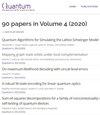通过测量阿贝尔边界对称系统构造稳定器代码
IF 5.1
2区 物理与天体物理
Q1 PHYSICS, MULTIDISCIPLINARY
引用次数: 0
摘要
我们提出了一个系统框架来构造一个$(d+1)$维稳定器模型。我们的方法建立在迭代测量程序的基础上,由[J]中的一位作者开发。Garre-Rubio, Nature comm . 15, 7986(2024)][12],其中初始对称状态被反复测量以获得在更高维度上支持其边界初始对称的紧急模型。该方法不仅可以构造作为基态的涌现态和相应的交换稳定器哈密顿量,而且还为这些模型提供了一种构造缺口边界条件的方法,这些边界条件相当于自发破坏部分边界对称性。在一个详细的介绍性示例中,我们通过迭代测量二维中的全局0型对称来构建三维clifford变形曲面代码,从而展示了我们的范式。然后,我们提供了我们的主要结果的证明,在此借鉴了威廉姆森测量过程的稍微扩展。在d=2中,我们还提供了两个例子,其中不同的i型分数阶是由测量初始线性子系统和Sierpinski分形对称产生的。在此过程中,我们提供了所有相关测量图和紧急状态的显式张量网络表示。本文章由计算机程序翻译,如有差异,请以英文原文为准。
Systematic construction of stabilizer codes via gauging abelian boundary symmetries
We propose a systematic framework to construct a $(d+1)$-dimensional stabilizer model from an initial generic d-dimensional abelian symmetry. Our approach builds upon the iterative gauging procedure, developed by one of the authors in [J. Garre-Rubio, Nature Commun. 15, 7986 (2024)][12], in which an initial symmetric state is repeatedly gauged to obtain an emergent model in one dimension higher that supports the initial symmetry at its boundary. This method not only enables the construction of emergent states and corresponding commuting stabilizer Hamiltonians of which they are ground states, but it also provides a way to construct gapped boundary conditions for these models that amount to spontaneously breaking part of the boundary symmetry. In a detailed introductory example, we showcase our paradigm by constructing three-dimensional Clifford-deformed surface codes from iteratively gauging a global 0-form symmetry that lives in two dimensions. We then provide a proof of our main result, hereby drawing upon a slight extension of the gauging procedure of Williamson. We additionally provide two more examples in $d=2$ in which different type-I fracton orders emerge from gauging initial linear subsystem and Sierpinski fractal symmetries. En passant, we provide explicit tensor network representations of all of the involved gauging maps and the emergent states.
求助全文
通过发布文献求助,成功后即可免费获取论文全文。
去求助
来源期刊

Quantum
Physics and Astronomy-Physics and Astronomy (miscellaneous)
CiteScore
9.20
自引率
10.90%
发文量
241
审稿时长
16 weeks
期刊介绍:
Quantum is an open-access peer-reviewed journal for quantum science and related fields. Quantum is non-profit and community-run: an effort by researchers and for researchers to make science more open and publishing more transparent and efficient.
 求助内容:
求助内容: 应助结果提醒方式:
应助结果提醒方式:


